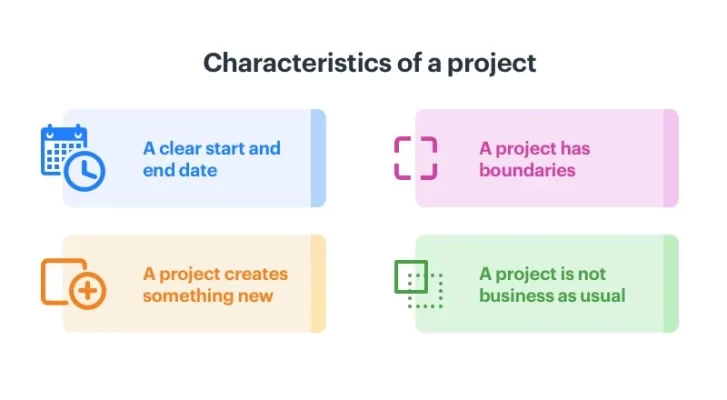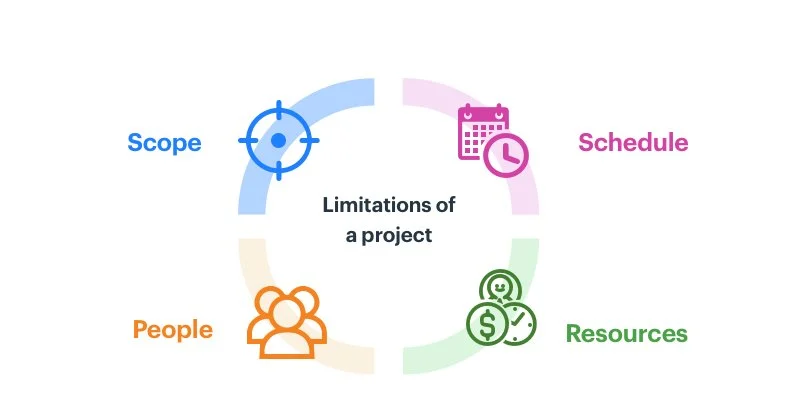A project is an order of activities that has to be finished in order to achieve a specific result. The Project Management Institute (PMI) defines a project as “any temporary endeavour with a definite beginning and end.” One person can manage it, or hundreds, depending on how complicated it is.
Characteristics of a Project
A project is a set of interdependent tasks that have a common goal. Projects have the following characteristics:

- A well-defined start and finish date: While some initiatives run for many years, they cannot continue indefinitely. It must start clearly, finish clearly, and provide a synopsis of the events that transpire in between.
- Originality: Every endeavour is original and produces something that did not exist before. A project is an action that happens once and never gets done exactly the same way again.
- Constraints: A project functions under specific time, financial, quality, and functional limitations. We shall see more of this in subsequent parts.
- Uniqueness: Often confused with processes, a project is not business as usual. A process is an ordered sequence of standard procedures used to carry out a certain task, such as authorising expense reimbursements. Not just one-time action, it sets up the way a certain function is carried out each and every time.
The Variety of the Initiatives
There are many different sizes and forms of projects. A project might:
- Be massive: Take years to finish and a huge expenditure, much like the Hoover Dam building.
- Be modest: Consider your weekend job of laying a walkway across your lawn.
- Involve several persons: Much as organising a wedding.
- Only you: Rearrange the pictures in your wedding album.
Project Sorting
The ways that projects are carried out can differ greatly. Project examples include the following:
- Conventional projects: These are carried out in phases and one after the other. Generally speaking, these phases are planning, execution, monitoring, and closing. Conventional project management is applied in most expensive infrastructure projects.
- Agile projects: Mainly utilised in software development. People-oriented and flexible, with usually short turnaround times.
- Remote projects: Teams who are dispersed and don’t often get together in person typically employ remote project management. One distant project would be managing independent contractors.
- Agency projects: Contracted out to an agency that probably has several clients on its books. Often, marketing and design jobs are contracted out to agencies.
The Project Boundaries
Every project functions inside preset parameters known as constraints:
- Focus of the project
- Timetable of the project
- Resources

Frontiers of Project Management
What and when the project intends to accomplish determines all of these project limitations. Projects end with deliverables. Deliverables include anything created throughout the project’s development, such as plans, reports, and papers. Another outcome of the project itself could be a deliverable.
Project management is different from operations carried out as usual in that it has a final deliverable and a limited timeframe. Unlike regular operations, most participants in projects are individuals who don’t typically collaborate. Sometimes the experts engaged will be from several locations and organisations. A project is seen to be successful if the intended result is reached on schedule and within budget.
Five Phases Make to a Project Lifetime
Five project stages, each with its own set of duties, goals, and deadlines, are common divisions of projects. Breaking a project into its component parts helps teams to maintain focus during its whole life cycle.
1. Introduction
Project initiation is the first stage of the life cycle of a project. A project formally begins here. It gets a name and a general plan is outlined. The limits, dangers, and stockholders of the project are listed together with the goals. Shareholders choose now whether or not to commit to the project. Studies may be done on the project to determine its viability. Usually, requirements are collected and examined for IT projects at the beginning.
2. Scheduling
Planning is the time to thoroughly design a roadmap that will direct teams from developing a project plan through the execution and closure phases of the project. Resources must be allocated, deadlines must be established. Organising work into smaller, more doable operations facilitates the management of project risks, expenses, quality, time, and so forth.
Conveniently dividing work into manageable chunks will also enable all parties concerned to complete the project on schedule and within budget.
3. Execution
The project plan is carried out in the stage of project execution. Teams will now work on the deliverables to guarantee the project satisfies the requirements. Everybody normally gets together for a meeting to officially launch the project so that teams may get to know one another and talk about their responsibilities in making it successful. Before the project plan is carried out, methods of communication and project management tools are determined.
Team members also get familiar with the reports and status meetings that will be held to gather project metrics throughout this phase. In the life cycle of a project, the project execution stage is crucial since it will enable everyone to ascertain whether or not their efforts will be worthwhile in the end.
4. Keeping an Eye On
Concurrent with the execution phase is the project monitoring and control phase. Overseeing operations and making sure everything is moving in the proper path as planned is the responsibility of the project manager. Project managers have to manage risks, keep an eye on resources, chair status meetings, write reports, and so forth in addition to supervising project performance. Should unanticipated problems surface, the project manager could have to modify the timetable and the plans.
5. Final Thoughts
Delivering the output itself is the easiest part of the project closing phase, the last stage of the project management life cycle. Throughout the project closure phase, project managers must turn over the project to the client or the team in charge of managing its operations, document all deliverables, and arrange documentation in one central location. Not only that, but teams get together for a last meeting to talk about the lessons they’ve learned and to recognise everyone’s effort.
When Does a Project Get Deemed Successful?
In brief, a project that is finished on schedule and within budget qualifies as successful. All the same, a project can be assessed according to several factors:
- Do business needs get met by it?
- Delivered on budget and on time?
- Is ROI and value as anticipated delivered?
The kind of project will probably determine what constitutes a successful one. That is the reason it is crucial to define project success in the beginning and planning stages of a project.
Approaching Project Implementation
Project execution can differ according to the approach applied. Project management done traditionally is carried out in five stages.
- Making the Project Case: Persuade the project stakeholders in the initiation phase. Basic project details including likely resource use and viability are included in a Project Initiation Document (PID).
- Planning: Once stakeholders give their consent to a project, this stage starts. Among the many chores at this crucial stage are resource sharing planning, task allocation, and contingency planning.
- Execution: Work really begins at this point. Reviewing on a regular basis helps to guarantee that execution occurs on time.
- Monitoring: Execution is followed by monitoring. It takes constant project management observation to guarantee that work proceeds without any problems.
- Closure: This stage involves the critical last activities of the project, such as delivering the product to the client and recording the lessons learned.
One can declare a project to have been implemented well once these stages are finished.
How Project Management Facilitates Project Administration
Projects can be extremely complicated endeavours requiring a great deal of time and money. Project management concepts will make the effort run well, whatever its objective. Without sound project management concepts, projects will be managed carelessly and run a far greater danger of:
- Project failure
- Project delay
- Project overrun
The likelihood of successfully finishing a project increases when one is familiar with the foundations of project management. Project management frameworks and techniques help organisations of all sizes and specialisations to lead their projects in the proper path.


